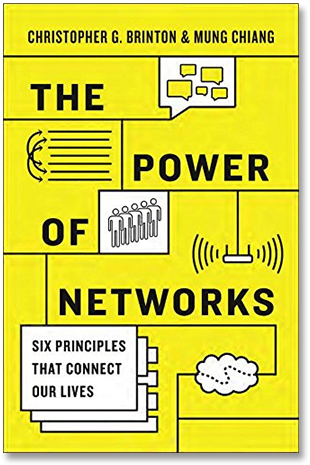The Power of Networks, book review: Life-changing connections


The Power of Networks: Six Principles that Connect Our Lives • By Christopher G. Brinton and Mung Chiang • Princeton University Press • 310 pages • ISBN: 978-0-691-17071-8 • £27.95
We don't normally think of our lives this way, but each of us is enmeshed in myriad networks -- the real-life one of people, social media like Twitter and Facebook, and technical networks (internet, cellular).
According to Christopher G Brinton, the head of advanced research at Zoomi, and Mung Chiang, a Princeton professor of electrical engineering, six principles govern all these networks, and understanding them enables you to understand how they work both for and against you. The fact that The Power of Networks reads like a textbook is easily explained: since 2012, Brinton and Chiang have offered a massive open online course (MOOC) to teach this material. Some supplemental extras are available on the book's website.
The book is, logically enough, divided into six sections, one for each principle. They are titled as follows: Sharing is hard; Ranking is hard; Crowds are wise; Crowds are not so wise; Divide and conquer; End to end.
This list of rather cryptic phrases hints at the book's main problem as a standalone work. There is no opening chapter that lists the principles in one place, explains how they were identified, or explains why these are the particular principles that matter. It may well be that this is an explanation the authors give at the beginning of their MOOC or one that they hope emerges over time through the course, but that doesn't help discretionary readers. Instead, after a brief prologue that calls these the "six key principles", the book then dives right into the first chapter's explanation of the design of cellular networks.
Each of the six sections has two or three sub-sections, each of which is a worked example of the principle in question.
'Sharing is hard' focuses on the design of physical -- wired and wireless -- connections and the technical tradeoffs that must be made in response to the changing nature of data traffic and pricing constraints. 'Ranking is hard' discusses the workings of search engines and explains the mechanics of ad pricing. 'Crowds are wise' looks at AI and recommendation systems. 'Crowds are not so wise' discusses the mathematics of making a video go 'viral' and networks of influence. 'Divide and conquer' is the story of the profound change brought to telecommunications networks by the internet. 'End to end' is about control: how connections are coordinated to avoid congestion on the internet, and then how the social graph enables "human routing". This section analyses Stanley Milgram's six degrees of separation and finds it plausible.
Several sections conclude with an interview with a relevant industry leader. Eric Schmidt says that "what most people think is true becomes the top ranking" -- nicely ironic given today's issues with fake news, although of course Schmidt focuses on the sunny side of Google. The other interviewees are internet pioneers Robert Kahn and Vint Cerf, and Dennis Strigl, the former head of Verizon. Strigl in particular includes an amusing historical anecdote: "Why would anyone want to do that?" he says he told the network's staff when they first showed him text messaging.
Overall, this book is a good exploration of these topics. I'd still like to know how they chose their principles, though.